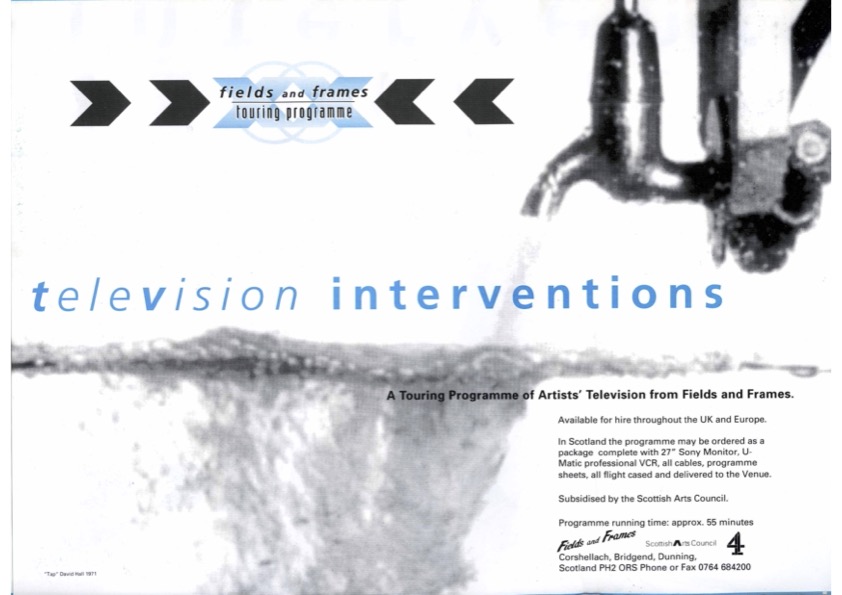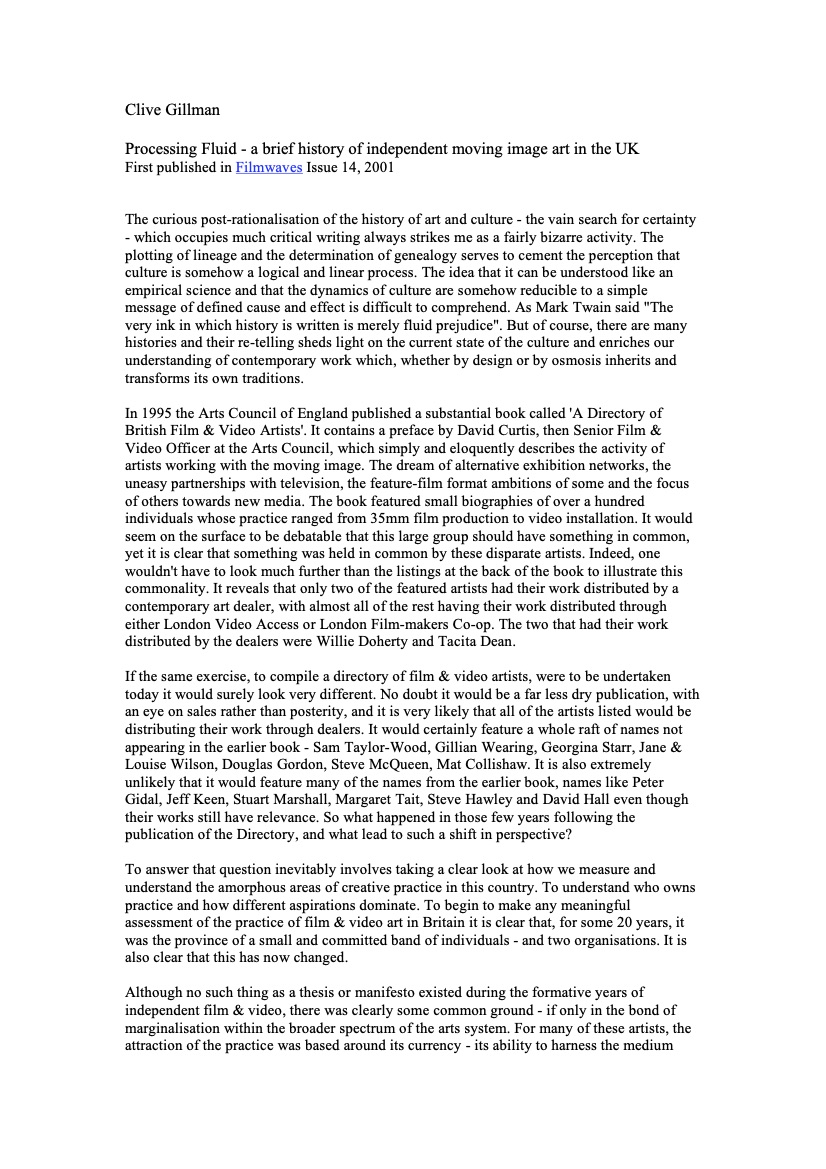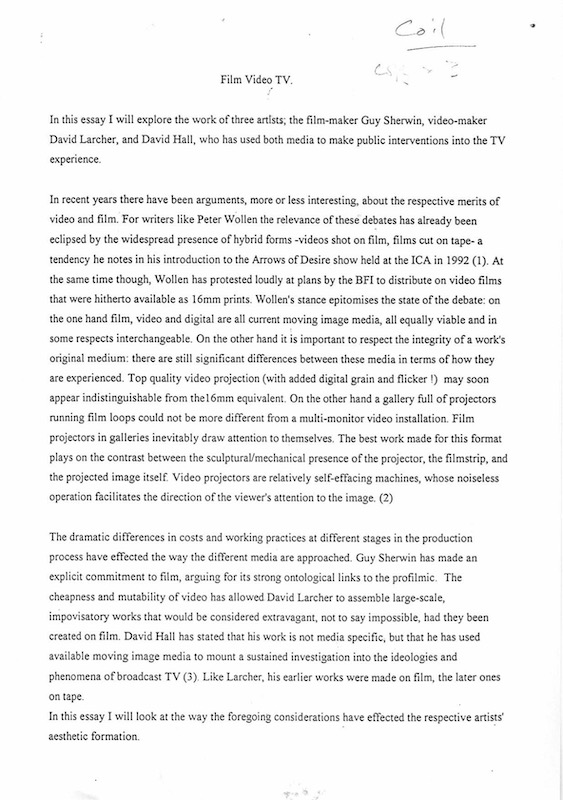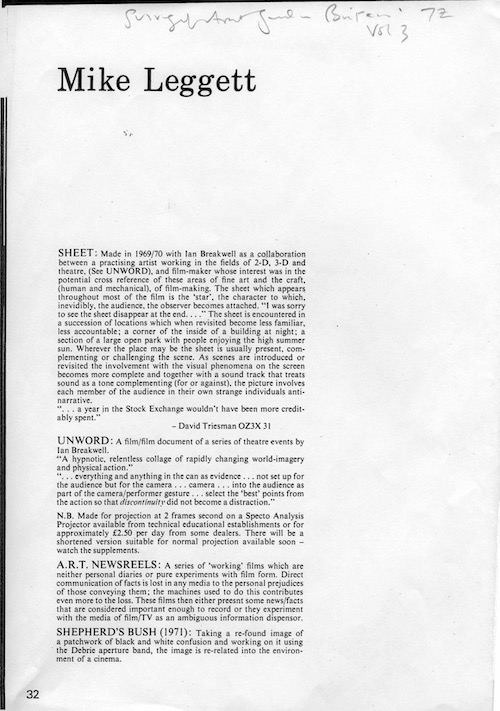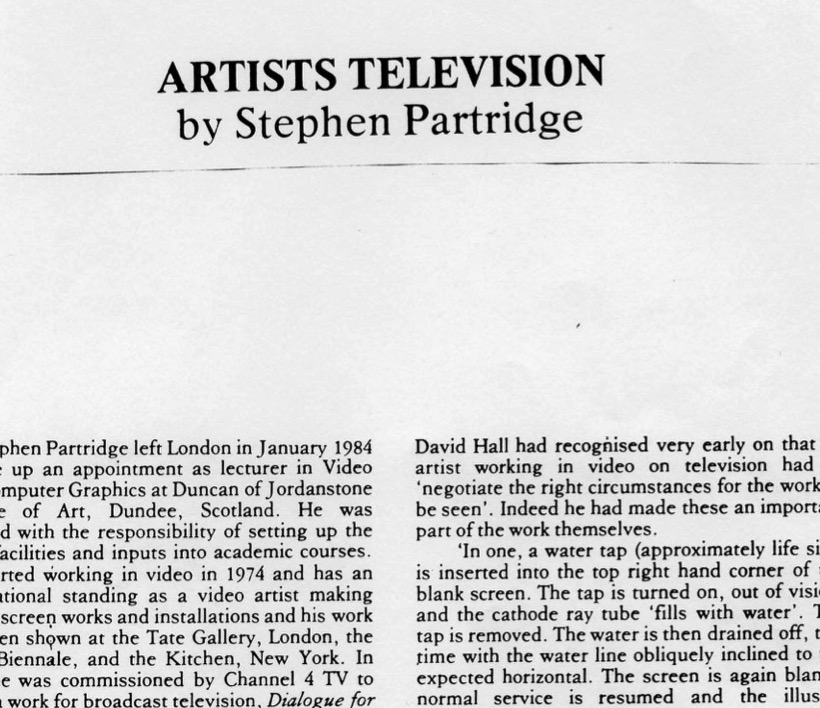TV Interruptions (7 TV Pieces) 1971
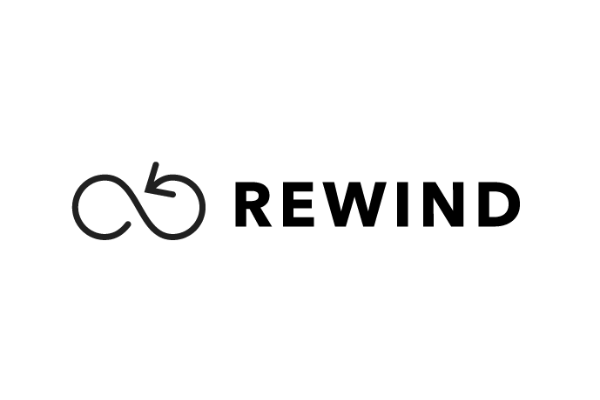
Creator:
Hall, DavidContributor(s):
- Ridley, Anna (Producer)
-
Tony Sinden
-
This work is part of the rewind archive.
Duration: 7 Parts: Interruption piece, 2.2mins Window piece, 2.2mins Tap piece, 3.3mins Time-lapse piece, 3.3mins Pans piece, 2.3mins TV shoot-out piece, 2.4minsT wo figures piece, 3.1mins
Year: 1971
Original formats:16mm Film
Broadcast: Scottish Television, 1971; and Channel 4 in 1990 (4 works only) as Part of 19:4:90 TV Interventions
Funding source: Scottish Arts Council, Self
First exhibited: Commissioned as part of the Scottish Arts Council's Locations Edinburgh event, 1971. Broadcast unannounced and uncredited by Scottish Television, 1971.
Exhibition Catalogues and Information
7 TV Pieces Preview Card for Royalty Preview Theatre, London, 1971. pdf here
Locations Edinburgh 1971, Catalogue, cover, credits and forward. pdf here
Locations Edinburgh 1971, David Hall detail Catalogue. pdf here
Programme for ‘English Avantgarde cinema’ at Millennium NY 1974. pdf here
ICA Programme Notes for ‘Vertical’, ‘7 TV Pieces’ and ‘Timecheck’, May 1972 pdf here
Exhibition brochure for Television Interventions, ‘A Touring programme of Artists’, Fields and Frames, 1993, includes information on the work TV Interruptions (7 TV Pieces).pdf here
Programme with information on works exhibited at ‘Cinematic Exploration – Expanding Screens 1960 – 1975’, January 25th – 30th 2004, Lumiere Cinema, includes Hall’s ‘T.V Interruptions (7 T.V pieces).pdf here
Essays and Articles
Videoart 78, Show Critique by Graham Wade. pdf here
TV Today press clipping referring to ‘7 TV Pieces’ and ‘Cinema’, 1972 pdf here
‘Kunst und Video’ document describing and depicting aspects of Hall’s works, Gruber and Vedder,’83 pdf here
Michael O’Pray charts the progress of independent video art for BFI monthly with reference to David Hall, 1988 pdf here
‘The national open art exhibition: Broadcast television and the visual arts’. Includes information on Hall’s ‘T.V Interruptions (7 T.V pieces)’.pdf here
‘David hall & Tony Sinden (for the catalogue), selected works and Bio, undated. pdf here.
‘Media of now: An interview with David Hall’ – interview with Joanna Heatwole, from the publication Afterimage: The Journal of Media Arts and Cultural Criticism, published by the Visual Studies Workshop, Rochester, New York, Volume 36, Aug/Sep 2008.pdf here.
ÎLive In Your Head Ò Concept and Experiment in Britain 1965 Ò 75Ì by Clive Phillpot and Andrea Tarsia, Whitechapel Gallery, London. Includes information on TV Interruptions (7 TV Pieces).pdf here
Text by David Hall
Text written by David Hall about 7 TV Pieces in 1971 pdf here
7 TV Pieces Text written by David Hall in 1991 for 19:4:90 Catalogue pdf here
Other
5 Films proposal to ACGB, including notes on 7 TV Pieces pdf here
Canal+ TV (France) licence purchase of parts of TV Interruptions pdf here
-
Quotes:
“Conceived and made specifically for broadcast, these were transmitted by Scottish TV during the Edinburgh Festival. The idea of inserting them as interruptions to regular programmes was crucial and a major influence on their content. That they appeared unannounced, with no titles, was essential.. These transmissions were a surprise, a mystery. No explanations, no excuses. Reactions were various. I viewed one piece in an old gents’ club. The TV was permanently on but the occupants were oblivious to it, reading newspapers or dozing. When the TV began to fill with water newspapers dropped, the dozing stopped. When the piece finished normal activity was resumed. When announcing to shop assistants and engineers in a local TV shop that another was about to appear they welcomed me in. When it finished I was obliged to leave by the back door. I took these as positive reactions…”
– David Hall, 19:4:90 Television Interventions cat., Third Eye Centre Glasgow and Ikon Gallery Birmingham, Fields and Frames 1990.‘Around the same time in Britain, David Hall, an experimental film maker who founded the first department for video art in the UK at Maidstone College of Art, made a series for the BBC entitled 7 TV Pieces. This series consisted of short black and white films, each of which playfully deconstructed the illusory space of the tv image whilst subverting the expectations of the television viewer. Some years later, Hall produced another work for the BBC, entitled This is a Television Receiver, in which the BBC’s most famous news anchor of the day read a technical description of what a television is and how it works. This short reading was repeatedly retaped by shooting the screen image, until both image and sound degraded to a point of almost total abstraction. Again in the late eighties, Hall was commissioned to make a work for television and on this occasion he reconstructed the first experimental tv transmission of the pioneer engineer John Logie Baird. Baird’s version of television was never commercially developed, and Hall’s work thus functions both as an archeological account of the early years of the medium and as critique of the linear history of technological development.’
Extract from – Exploding. Plastic & Inevitable, Jeremy Welsh, web 3.02.02 – Written for the exhibition “Video Works” at Kunstnernes Hus, Oslo, 2002.‘…Although each Piece has its own specific quality and repays repeated viewing in varying degrees, Hall has insisted [that] ‘the pieces were not intended as declarations of art in their own right, they did not assume that privilege. They were gestures and foils within the context of..TV. They needed TV, they depended on it.’ Hall is critical of specialist arts programmes [art galleries on air] which ‘call the few and exclude the many’, and in a letter to Studio International [March 1972] Alistair MacIntosh, curator of the Edinburgh event, echoed Hall’s strictures. He pointed out that the Pieces reached ‘an audience of 250,000 per night. They didn’t know what they were looking at and didn’t expect it, so all the rubbish surrounding art was circumvented.’ – Mick Hartney on TV Interruptions 1971 in the book Diverse Practices: A Critical Reader on British Video Art (Arts Council of England/ John Libbey) 1996
‘Tap’ is probably the most well-known of the ‘7 TV Pieces’. Unseen hands place a tap inside a glass tank, framed so that the tank’s edges coincide with the sides of the TV. The tap is turned on, filling the space with water until it itself is submerged. The tank continues to fill until the meniscus – the surface line of the water – rises out of view. The tap is withdrawn and turned off, leaving that most forbidden of things, a blank silent screen. After a pause of several seconds the plug is pulled and the tank empties, now with the meniscus cutting acoss the screen at a 45 degree angle. Beyond the reference to the box as as glass-fronted container, the piece serves to demonstrate how framing is crucial in determining how we understand an image, and hence how meaning is created, not just by what framing includes, but also in the sense of the editorial function is performs. This leads to a wider reading of the work as a critique of the largely invisible editorial practices of programme makers and indeed the TV institutions… – Nicky Hamlyn in Coil magazine 9/10, London 2000
‘…the Pieces [were not] calculated simply to alert or confuse the TV audience. In one ‘Two Figures’ the respective stillness and frenetic movement of the figures in a room depended for its perceptual effect on a complex interpretative process on the part of the viewer whereby the ‘reading’ of the technical manipulation of the scene – i.e. the unnatural acceleration of the moving figure – is subverted by the prolonged stationary presence of the seated figure. In this Piece – in my opinion the strongest – by juxtaposing within a single scene a figure whose behaviour is largely cinematically-generated with one whose appearance suggests the medium is transparent, Hall brought vividly to the fore the inherent contradictions of that medium.’ – Mick Hartney in Diverse Practices: A Critical Reader on British Video Art,1996.
ZKM Internet quotes about David hall’s 7 TV Pieces pdf here



